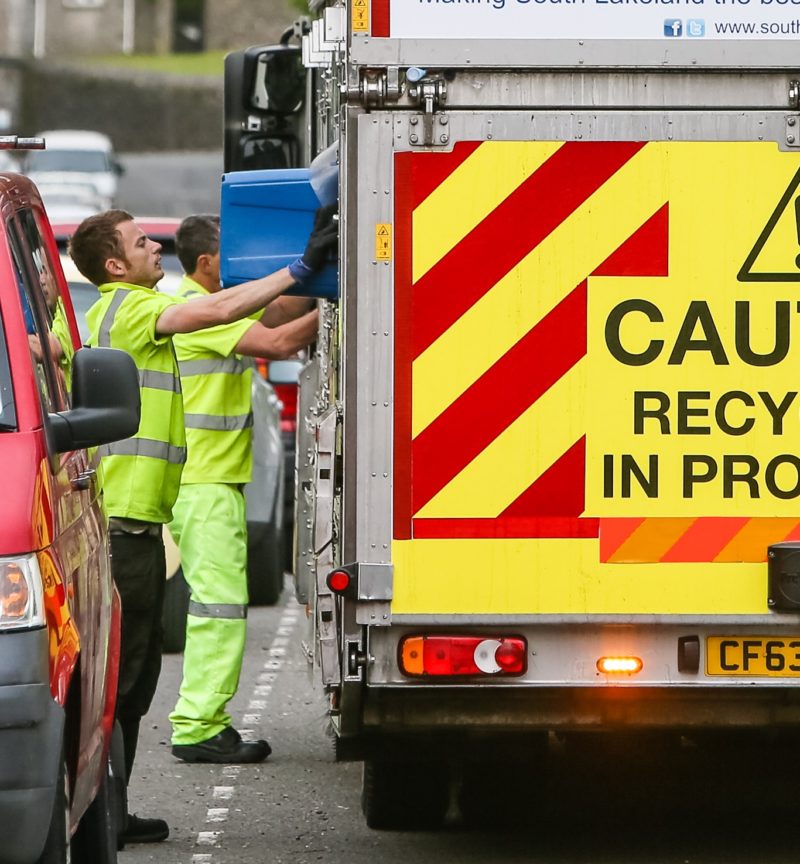South Lakeland district council is switching to smaller recycling boxes to reduce the “potential risk” of injury to council staff and householders.
The 44-litre blue boxes being distributed to householders are the same length and width, but slightly shallower than the existing 55-litre boxes, the council says. The aim of the move is to reduce the weight of the boxes, which the council says will limit the risk of back injuries to those carrying and emptying containers.

South Lakeland has reduced the size of boxes used as part of its kerbside recycling service
According to the authority, the move took into account a study from the Health and Safety Executive dating back to 2006 showing “clear evidence associated with the risk factors of the weight and frequency of manual handling of 55-litre boxes”.
South Lakeland’s kerbside collection service was changed in 2018, which involved revised rounds, the introduction of new vehicles and delivery of new bags and communications to 53,000 properties. This enabled more households which were on glass, cans and paper recycling collections to add plastic and cardboard to their recyclables collected from the kerbside.
Collections are carried out by an in-house team with alternate weekly collections for recycling and residual waste. Recycling collections include blue boxes (one for glass and one for paper/cardboard), and a bag for plastic/tin.
Research
On the safety issue, HSE’s 2006 research looked at manual handling in domestic recycling schemes where householders are provided with boxes to put out recyclable materials for collection (see letsrecycle.com story).
An investigation into the risks for musculoskeletal disorders to waste/recycling collectors engaged in kerbside collection of recyclables was undertaken to provide “authoritative guidance” on control measures to limit risk within existing systems.
According to HSE, musculoskeletal disorders cover any injury, damage or disorder of the joints or other tissues in the upper/lower limbs or the back.
The report found that the implementation of kerbside box collection schemes, that require refuse collectors to lift and carry a box and potentially sort the contents at the vehicle, has “potentially increased the risk of manual handling injuries”.
And the report recommended: “Where boxes are used, reduce the capacity of the boxes to at most 40 litres to provide a method of weight control.”
According to the report, the maximum weight observed for a 40 litre box containing mixed glass and newspaper, including a lid, was 12.8 kg. “This figure is below the level likely to exceed the NIOSH 3.4kN biomechanical criterion,” the report found. “Also, this weight is acceptable to at least 90% of the British male adult population.”
‘Win-win’
“It is a win-win situation if a simple measure like reducing the height of our blue recycling boxes can reduce the potential risk to staff’s health and wellbeing”.
Cllr Dyan Jones
South Lakeland council
Commenting on the changes, Councillor Dyan Jones, portfolio holder for the environment on the SLDC cabinet, said: “The latest council performance figures in October showed that the council was performing well against its recycling targets and the phased introduction of 44-litre blue recycling boxes will not affect that performance.
The council achieved 44.4% recycling rate in 2017/18 – an increase from 42.4% the previous year.
“Our excellent waste collection teams play a huge part in facilitating this success,” Cllr Jones said. “And it is a win-win situation if a simple measure like reducing the height of our blue recycling boxes can reduce the potential risk to staff’s health and wellbeing”.
Related links
HSE report
The post ‘Injury risk’ sees South Lakes reduce recycling box size appeared first on letsrecycle.com.
Source: letsrecycle.com Waste Managment



